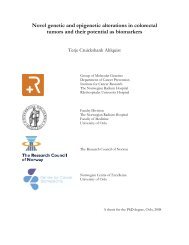Preface - Ous-research.no
Preface - Ous-research.no
Preface - Ous-research.no
Create successful ePaper yourself
Turn your PDF publications into a flip-book with our unique Google optimized e-Paper software.
Role of the Liver X receptors (LXRs) in inflammatory modulation<br />
Principal investigator:<br />
Joanna Ågren, MD, PhD student (OUH/UiO)<br />
Supervisors<br />
Maria K. Dahle, PhD (UiO)<br />
Michael R. Daws, PhD (UiO)<br />
Håvard Attramadal, Professor, MD, PhD (OUH/UiO)<br />
Research area<br />
Sepsis is a clinical syndrome where an infection (e.g. pneumonia or urinary tract infection)<br />
causes systemic illness. Delayed initiation of treatment may lead to organ failure (severe<br />
sepsis) and/or septic shock. Severe sepsis has an overall incidence of 2.8/1000 population<br />
and a mortality rate of 30%. It is believed that sepsis, and the following organ injury, develops<br />
when the body’s own regulation of the inflammatory responses to an infection is out<br />
of control and defense mechanisms overshoot, rather than from the infectious agent alone.<br />
Thus, the complex pathogenesis of sepsis involves several factors, including dysregulation<br />
of the immune and endocrine systems, disseminated intravascular coagulation (DIC), genetic<br />
susceptibility, and derangement of energy metabolism.<br />
Aims<br />
Our major aim is to study factors that may modulate the overshooting inflammatory responses in sepsis and promote a better balanced<br />
immune defense. We believe that the liver X receptor (LXR) may have such properties and intend to elucidate the potential of LXR<br />
as an inflammatory modulator in sepsis.<br />
Liver X Receptor and Inflammation<br />
Liver X receptor (LXR) is a ligand binding transcription factor and belong to the family of nuclear hormone receptors. The two subtypes<br />
of LXR, LXRα and LXRβ, sense intracellular metabolites of cholesterol and are important regulators of cholesterol, fatty acid and<br />
glucose metabolism. Studies have also indicated that the LXRs are involved in regulation of both acute and chronic inflammation. We<br />
have previously demonstrated that activation of LXR by a synthetic agonist (GW3965) reduces liver injury and modulates systemic<br />
inflammation in rats subjected to acute endotoxemia or polymicrobial sepsis, and that liver injury is increased in LXR-deficient mice in<br />
the same models. Our in vitro studies have also shown that the release of pro-inflammatory mediators from white blood cells (Kupffer<br />
cells (liver macrophages) and human mo<strong>no</strong>cytes) is reduced when the cells are pretreated with the synthetic LXR agonist before<br />
stimulation with the gram negative cell wall component lipopolysaccharide (LPS).<br />
To study the impact of LXR on inflammation, we use models that closely resembles the endoge<strong>no</strong>us responses during an infection. For<br />
example, we use a model of human whole blood as well as cultures of freshly isolated human white blood cells (mo<strong>no</strong>cytes, macrophages,<br />
neutrophils and T cells). We also use murine models to study the systemic effect of LXR on inflammation. The cecal ligation<br />
and puncture model resembles acute polymicrobial sepsis, and the oil induced arthritis model is used to study immune responses in<br />
chronic inflammatory disease.<br />
In 2010, the focus has mainly been on the different subtypes of LXR and their individual impact on inflammatory responses. In particular,<br />
we have studied cytokine responses and markers of macrophage polarization and apoptosis following CLP in organs from mice<br />
deficient in either LXRα or LXRβ. In parallel, we have studied the effects of LXRα or LXRβ k<strong>no</strong>ckdown by siRNA on cytokine responses<br />
in human macrophages. Furthermore, at the immu<strong>no</strong>biological laboratory at the Department of Anatomy, Institute of Basic Medical<br />
Sciences, UiO, we have studied the effect of LXR activation on the development of oil induced arthritis and on the migration of dendritic<br />
cells to lymph <strong>no</strong>des in this model.<br />
56
















